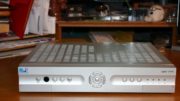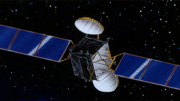Every couple of years… someone starts talking about the idea of merging DIRECTV and DISH. It’s not so far-fetched… in fact the two companies did discuss the idea over 10 years ago but the regulatory climate wasn’t right. So, if it was good then, it should be good now, right?
Things have changed a lot since then. DIRECTV and DISH have gone their separate ways in technology, and both companies now have many, many more subscribers. Financial analysts may think the two companies would be a good fit for each other but let’s take a look at the details.
Technology
Ten years ago, both companies used single-LNB systems that didn’t stray too far from the basic DSS model laid out in the 1980s. Both used an 18″ dish and primarily pointed at a single satellite. Today, both companies have launched multiple satellites and use totally incompatible dishes. DISH has created two completely different fleets, one for the eastern US and one for the west. DIRECTV has created a single fleet with three primary locations and three secondary locations, and a variety of dishes to be used depending on the user’s location.
Both companies have also taken radically different approaches to the idea of multiple receivers. DISH limits the number of receivers on one dish using its own switching technology. DIRECTV uses an incredibly complex system to put all signals on a single wire, and to allow for a virtually unlimited number of receivers from a single dish. These two systems are so different that there is no way that you could ever hope to combine them.
DISH and DIRECTV also use different technologies for encoding their programming, but compared to the challenges of just getting a signal to the receiver that’s not as big of a deal.
Business model
Corporate cultures between DISH and DIRECTV have never been more different. DISH has made it clear that they want to expand out of the satellite business into other wireless endeavors. On the other hand, DIRECTV has doubled down on satellite TV, expanding its purview outside the US (where DISH has no presence) into Latin America. It may seem that both companies would benefit from merging the different corporate philosophies, but it’s more likely that top management officers between the two would clash about the best way to proceed, leading to one philosophy or the other being completely abandoned.
Attitudes to litigation
This is perhaps the most important difference between the two companies. In the last decade, DISH has adopted a “do first, defend later” philosophy. DISH has battled foe after foe in court. TiVo and DISH had a longstanding patent feud and DISH has never shied from the idea that they can defend any action they take. This has led to them being first in dual buffering DVRs, placeshifting, tablet apps, and other high-tech addons. Sometimes these features have landed DISH in court, and even today DISH is battling its Auto Hop feature that allows for automatic commercial skipping.
In contrast, DIRECTV never seems to do anything without clear assurance from its lawyers that they won’t get sued. This is most apparent in its DIRECTV Everywhere initiative, which, while improving every day, is still far behind other providers in offering out-of-home viewing of its programming. DIRECTV is said to own a patent on commercial skipping due it its purchase of ReplayTV many years ago, yet it has never even tried to implement automated skipping.
This approach leaves DIRECTV behind in key sectors, but keeps profits up that would otherwise have gone to expensive settlements.
There is simply no way to reconcile these two philosophies. A merged DIRECTV/DISH company would inherit all the lawsuits from DISH and all the litigation-shy attorneys from DIRECTV, and there’s very little good that can come from that. It would take years to deal with lawsuits. In the meantime, DIRECTV users would still live without those advanced features that others take for granted; possibly DIRECTV users could be locked out from future improvements for a decade.
Conclusion
The bottom line is simple: The two companies are as different as two companies can be when they offer what is essentially the same product. The market would not sit still for ten years while the two product lines were merged, and most likely the result would be a single company that was weaker than either of its two parents.





